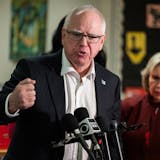The number of Minnesotans visiting food shelves has eased slightly this year after a dramatic increase in 2020 because of the COVID-19 outbreak, but the need is rising again.
The state's 350 food shelves are on pace to end 2021 with 3.7 million visits, just below the record 3.8 million in 2020, according to Hunger Solutions Minnesota, a statewide hunger relief advocacy organization. And officials say they're seeing the number of people relying on food shelves edging up as other aid wanes.
"People in poverty take a longer time to bounce back," said Tikki Brown, assistant commissioner for children and family services at the state Department of Human Services. "We still are seeing a need for all of the different types of food supports, but maybe just not at that extreme heightened need that we saw in the early days and in the middle of the pandemic."
While Minnesota's unemployment rate is inching down to pre-pandemic levels and job vacancies have spiked, soaring rents and high inflation driving up the cost of everything from gasoline to groceries are crippling low-income residents who likely were financially strained before the pandemic.
Evictions also are nearing pre-pandemic levels, and as additional government aid for programs such as housing assistance shuts down next year, the number of residents in need of food assistance is expected to climb again in 2022.
"I think that, as all of these programs blink off ... you'll start to see the numbers increasing," said Colleen Moriarty, executive director of Hunger Solutions.
In some places, it's already happening. Joyce Uptown Food Shelf in Minneapolis is extending its hours to accommodate a record number of people this year, up 40% from last year. In Brooklyn Center, the number of new participants is up 30% from 2020 at CEAP (Community Emergency Assistance Programs), which is fundraising to launch a new mobile food program.
And in Bloomington, cars start lining up a half-hour before the food shelf opens at Volunteers Enlisted to Assist People (VEAP). While the number of food shelf visitors there has dipped below 2020's numbers, the nonprofit has doled out nearly double the amount of housing and utility assistance to people in need.
![A black bear stopped after crossing Big Bay Road on Madeline Island, the largest of the Apostle Islands in Wisconsin, on Monday, May 31, 2021. ]](https://arc.stimg.co/startribunemedia/PWNYGIY3WTSWDBOGOYD775DPP4.jpg?&w=80&ar=1:1&fit=crop)

